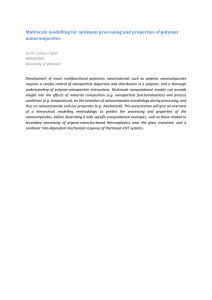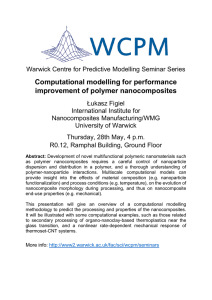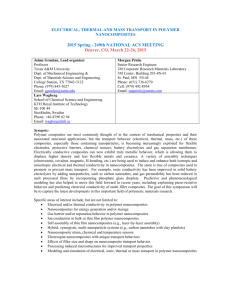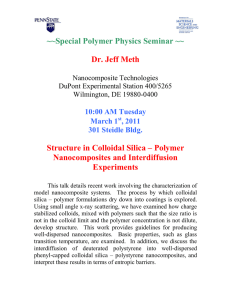PP–PP-g-MAH–Org-MMT Nanocomposites. I. Intercalation Behavior and Microstructure Weibing Xu, Guodong Liang,
advertisement
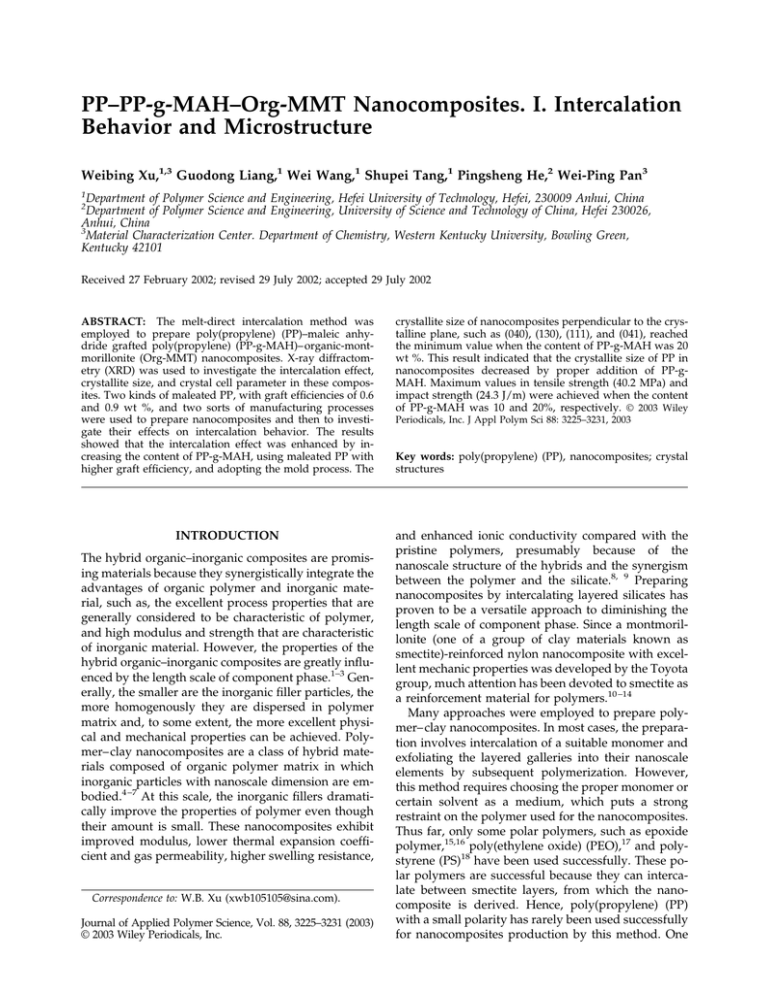
PP–PP-g-MAH–Org-MMT Nanocomposites. I. Intercalation
Behavior and Microstructure
Weibing Xu,1,3 Guodong Liang,1 Wei Wang,1 Shupei Tang,1 Pingsheng He,2 Wei-Ping Pan3
1
Department of Polymer Science and Engineering, Hefei University of Technology, Hefei, 230009 Anhui, China
Department of Polymer Science and Engineering, University of Science and Technology of China, Hefei 230026,
Anhui, China
3
Material Characterization Center. Department of Chemistry, Western Kentucky University, Bowling Green,
Kentucky 42101
2
Received 27 February 2002; revised 29 July 2002; accepted 29 July 2002
ABSTRACT: The melt-direct intercalation method was
employed to prepare poly(propylene) (PP)–maleic anhydride grafted poly(propylene) (PP-g-MAH)– organic-montmorillonite (Org-MMT) nanocomposites. X-ray diffractometry (XRD) was used to investigate the intercalation effect,
crystallite size, and crystal cell parameter in these composites. Two kinds of maleated PP, with graft efficiencies of 0.6
and 0.9 wt %, and two sorts of manufacturing processes
were used to prepare nanocomposites and then to investigate their effects on intercalation behavior. The results
showed that the intercalation effect was enhanced by increasing the content of PP-g-MAH, using maleated PP with
higher graft efficiency, and adopting the mold process. The
INTRODUCTION
The hybrid organic–inorganic composites are promising materials because they synergistically integrate the
advantages of organic polymer and inorganic material, such as, the excellent process properties that are
generally considered to be characteristic of polymer,
and high modulus and strength that are characteristic
of inorganic material. However, the properties of the
hybrid organic–inorganic composites are greatly influenced by the length scale of component phase.1–3 Generally, the smaller are the inorganic filler particles, the
more homogenously they are dispersed in polymer
matrix and, to some extent, the more excellent physical and mechanical properties can be achieved. Polymer– clay nanocomposites are a class of hybrid materials composed of organic polymer matrix in which
inorganic particles with nanoscale dimension are embodied.4 –7 At this scale, the inorganic fillers dramatically improve the properties of polymer even though
their amount is small. These nanocomposites exhibit
improved modulus, lower thermal expansion coefficient and gas permeability, higher swelling resistance,
Correspondence to: W.B. Xu (xwb105105@sina.com).
Journal of Applied Polymer Science, Vol. 88, 3225–3231 (2003)
© 2003 Wiley Periodicals, Inc.
crystallite size of nanocomposites perpendicular to the crystalline plane, such as (040), (130), (111), and (041), reached
the minimum value when the content of PP-g-MAH was 20
wt %. This result indicated that the crystallite size of PP in
nanocomposites decreased by proper addition of PP-gMAH. Maximum values in tensile strength (40.2 MPa) and
impact strength (24.3 J/m) were achieved when the content
of PP-g-MAH was 10 and 20%, respectively. © 2003 Wiley
Periodicals, Inc. J Appl Polym Sci 88: 3225–3231, 2003
Key words: poly(propylene) (PP), nanocomposites; crystal
structures
and enhanced ionic conductivity compared with the
pristine polymers, presumably because of the
nanoscale structure of the hybrids and the synergism
between the polymer and the silicate.8, 9 Preparing
nanocomposites by intercalating layered silicates has
proven to be a versatile approach to diminishing the
length scale of component phase. Since a montmorillonite (one of a group of clay materials known as
smectite)-reinforced nylon nanocomposite with excellent mechanic properties was developed by the Toyota
group, much attention has been devoted to smectite as
a reinforcement material for polymers.10 –14
Many approaches were employed to prepare polymer– clay nanocomposites. In most cases, the preparation involves intercalation of a suitable monomer and
exfoliating the layered galleries into their nanoscale
elements by subsequent polymerization. However,
this method requires choosing the proper monomer or
certain solvent as a medium, which puts a strong
restraint on the polymer used for the nanocomposites.
Thus far, only some polar polymers, such as epoxide
polymer,15,16 poly(ethylene oxide) (PEO),17 and polystyrene (PS)18 have been used successfully. These polar polymers are successful because they can intercalate between smectite layers, from which the nanocomposite is derived. Hence, poly(propylene) (PP)
with a small polarity has rarely been used successfully
for nanocomposites production by this method. One
3226
XU ET AL.
Figure 1 XRD patterns of Org-MMT (a) and PP–PP-g-MAH–Org-MMT nanocomposites with the following proportions:
(b)98:0:2, (c) 92:6:2, (d) 98;10:2, (e) 78:20:2, and (f) 68:30:2 (PP-g-MAH with graft efficiency of 0.6 wt %; mold process).
promising approach to such nanocomposite production is by direct polymer melt intercalation processing,
which is simple to operate and friendly to the environment. Many polymer systems (e.g., PS, polyamide,
and PEO) containing silicate have been prepared in
this way.
PP is one of the most widely used polyolefin polymers. However, because it does not include any polar
groups in its backbone, it was not thought that homogenous dispersion of the silicate layers in PP would
be realized. In general, clay is modified with alkylammonium (the alkylammonium makes the hydrophilic
clay surface organophilic) to facilitate its interaction
with a polymer matrix; For examples, Kato et al. prepared PP-based nanocomposites by melt blending
three components [PP, PP–maleic acid (PP–MA), and
modified clay] in a twin-screw extruder,19,20 and Wolf
described that swollen organomodified clay was compounded with PP in a twin-screw extruder at 250°C to
yield PP– organomodified clay nanocomposites.21 In
our previous studies, PP– organic-montmorillonite
(PP–Org-MMT) nanocomposites were obtained by diTABLE I
2 and d Values for Org-MMT and PP/PP-g-MAH
(With Graft Efficiency of 0.6 wt %)/Org-MMT
Nanocomposites (Mould Process)
2 (deg)
d (nm)
PP/PP-g-MAH/org-MMT
(001)
(002)
(001)
(002)
0/0/100
98/0/2
92/6/2
88/10/2
78/20/2
68/30/2
4.64
4.60
4.5
2.46
2.32
2.30
—
—
—
4.84
4.72
4.90
1.90
1.92
1.96
3.59
3.80
3.84
—
—
—
1.82
1.87
1.80
rect melt blending of a special brand of PP and OrgMMT.13,22
In this study, another brand of PP was used, and
PP–maleic anhydride-grafted PP–Org-MMT (PP–PPg-MAH–Org-MMT) nanocomposites were synthesized successfully by a different direct melt intercalation process (i.e., a mold or injection process). The
crystallite size and crystal cell parameters of PP–PPg-MAH–Org-MMT nanocomposites were investigated
by X-ray diffraction (XRD) analysis. In addition, the
mechanical properties of the PP–PP-g-MAH–OrgMMT composites were examined.
EXPERIMENTAL
Materials
Poly(propylene) (PP; FY4012 brand) used was purchased from The Polyolefin Company, Ltd. (Singapore) and used without any treatment. Maleated
poly(propylene) [i.e., maleic anhydride-grafted PP
(PP-g-MAH)], with graft efficiencies of 0.6 and 0.9 wt
%, were prepared by reactive extrusion in our own
laboratory.23 Na⫹-Montmorillonite was available from
Lin’an Chemistry Agent Factory (China), and organicmontmorillonite (Org-MMT) was synthesized in our
own laboratory according to a previously published
procedure.24
Preparation of PP–PP-g-MAH–Org-MMT
Mold process
PP-g-MAH and Org-MMT were melt mixed in roller
mill at 175–180°C for 15 min under prescribed conditions to make a master batch. Then, the master batch
PP–PP-g-MAH–ORG-MMT NANOCOMPOSITES. II.
3227
Figure 2 XRD patterns of Org-MMT(a) and PP–PP-g-MAH–Org-MMT composites with the following proportions: (b)98:0:2,
(c) 92:6:2, (d) 98;10:2, (e) 78:20:2, and (f) 68:30:2 (PP-g-MAH with graft efficiency of 0.9 wt %; mold process).
and conventional PP were melt mixed under prescribed conditions in a roller mill at 175–180°C for 15
min. The resulting sheet was compression molded at
180°C for 30 min into a plate with a thickness of 4 mm.
Injection process
The master batch and conventional PP were melt
mixed in a screw extruder (SJ-45B) with a rotational
speed of 24 r/min. The resulting extrudate was cooled
with cool water, and then was cut into pellet that was
kept in oven for 4 h at 80°C. The resulting particle was
injected into a measuring sample in a plastics injection
machine (XS-ZY-125A).
Measurements
X-ray diffraction analysis (XRD) was carried out to
confirm whether the PP–PP-g-MAH–Org-MMT nanoTABLE II
2 and d Values for Org-MMT and PP/PP-g-MAH
(With Graft Efficiency of 0.9 wt %)/Org-MMT
Nanocomposites (Mould Process)
2/deg
d/nm
PP/PP-g/MAH/Org-MMT
(001)
(002)
(001)
(002)
0/0/100
98/0/2
88/10/2
78/20/2
68/30/2
4.64
4.62
2.36
2.20
2.14
—
—
4.74
4.66
4.50
1.90
1.91
3.74
4.01
4.12
—
—
1.86
1.89
2.14
composites were formed and investigate the intercalation effect of the nanocomposites. A D/max-␥B diffractometer was employed, with Cu-K␣ radiation and
graphite filter, at room temperature. The XRD patterns
were scanned in the 2 range 1.2–10° at a rate of
1°/min. The interlayer distance of Org-MMT in composites was calculated from the (001) peak with the
Bragg equation. The D/max-␥B diffractometer was
also employed to certify the crystal type of PP in the
mentioned composites and to investigate the change
of crystallite size and crystal cell parameters of PP in
the composites. The diffractograms were scanned in
the 2 range 2.2–30° and at a rate of 2°/min.
The tensile test was carried out with a Model LJ1000 testing machine at a crosshead speed of 50 mm/
min at room temperature. The Izod impact test was
examined with a Model IZODUJ-4 impact testing machine at room temperature according to GB1040-1996
and GB1843-1986. The specimens used were prepared
with a vulcanization machine (QLB400 ⫻ 400 ⫻ 2) by
compression molding.
RESULTS AND DISCUSSION
Effect of the amount of PP-g-MAH on intercalation
behavior
The XRD patterns of PP–PP-g-MAH–Org-MMT composites are shown in Figure 1 and the XRD parameters
calculated form the (001) peaks are summarized in
Table I. When the content of PP-g-MAH was ⬎10 wt %
in the PP–PP-g-MAH–Org-MMT composites, the (001)
3228
XU ET AL.
Figure 3 XRD patterns of Org-MMT(a) and PP–PP-g-MAH–Org-MMT composites with the following proportions: (b)98:0:2,
(c) 92:6:2, (d) 98;10:2, (e) 78:20:2, and (f) 68:30:2 (PP-g-MAH with graft efficiency of 0.9 wt %; injection process).
plane peaks of Org-MMT at ⬃2 ⫽ 4.6° in the XRD
patterns, as expected, were shifted to lower angles of
⬃2 ⫽ 2.3°. These results mean that the interlayer
distance was increased from 1.9 to 3.8 nm, which
clearly indicates that macromolecule chains had intercalated into the galleries of Org-MMT. However, the
result is quite different from that which occurred
when the content of PP-g-MAH was ⬍10 wt %; that is,
the (001) peak of Org-MMT did not shift. This result
indicates that the nonpolar macromolecule segments
of PP can hardly intercalate into the interlayers of
Org-MMT and that adding PP-g-MAH to the PP–OrgMMT composite is the key to preparing nanocomposites based on PP and Org-MMT. Moreover, the interlayer distance of PP–PP-g-MAH–Org-MMT increased
with increasing the content of PP-g-MMT in PP–PP-gMAH–Org-MMT, but the trend became insufficient
when the content of PP-g-MAH was ⬎20 wt %, which
indicated that the intercalation effect of PP–PP-gTABLE III
2 and d Values for Org-MMT and PP/PP-g-MAH (With
Graft Efficiency of 0.9 wt %)/Org-MMT Nanocomposites
(Injection Process)
2/deg
d/nm
PP/PP-g-MAH/Org/MMT
(001)
(002)
(001)
(002)
0/0/100
98/0/2
88/10/2
78/20/2
68/30/2
4.64
4.58
2.60
2.40
2.20
—
—
4.82
4.52
4.50
1.90
1.93
3.39
3.68
4.01
—
—
1.82
1.95
1.96
MAH–Org-MMT could be enhanced by increasing the
content of PP-g-MAH. This enhancement of intercalation can be explained as follows: when a small amount
of PP-g-MAH is included in PP–PP-g-MAH–OrgMMT, instead of intercalating into interlayers of OrgMMT, the macromolecule links of PP-g-MAH wrap
around the particle of Org-MMT. Only when adequate
PP-g-MAH is present in PP–PP-g-MAH–Org-MMT
does Org-MMT begin to be intercalated. However,
when PP-g-MAH is adequate for amply intercalating
interlayers of Org-MMT, increasing the amount of
PP-g-MAH will not further contribute to intercalation
effect of PP–PP-g-MAH–Org-MMT.
Effect of graft efficiency of PP-g-MAH on the
intercalation behavior
Maleated PP with 0.9 wt % grafted MA was used to
synthesize PP–PP-g-MAH–Org-MMT nanocomposites to compare with maleated PP with 0.6 wt %
grafted MA. As seen in Figure 2 and Table II, with
increasing content of PP-g-MAH, the intercalation behavior in PP–PP-g-MAH–Org-MMT (with PP-g-MAH
graft efficiency of 0.9 wt %) performed according to
the same rule as did PP–PP-g-MAH–Org-MMT (with
PP-g-MAH graft efficiency of 0.6 wt %) shown in
Figure 1 and Table I. However, under certain conditions, the (001) plane peak for PP–PP-g-MAH–OrgMMT (with PP-g-MAH graft efficiency of 0.9 wt %)
occurred at smaller angle than that of PP–PP-g-MAH–
Org-MMT (with PP-g-MAH graft efficiency of 0.6 wt
%). This result indicated that higher MAH graft effi-
PP–PP-g-MAH–ORG-MMT NANOCOMPOSITES. II.
3229
Figure 4 XRD patterns for PP(a) and PP–PP-g-MAH–Org-MMT nanocomposites with the following proportions: (b)98:0:2,
(c) 92:6:2, (d) 98;10:2, (e) 78:20:2, and (f) 68:30:2 (PP-g-MAH with graft efficiency of 0.6 wt %; mold process).
ciency of PP-g-MAH will contribute to a better intercalation effect. This improved intercalation effect can
be explained as follows: more polar groups, with
higher graft efficiency, are included in PP-g-MAH,
and these polar groups perform a very important role
during the intercalation process. These results are consistent with those of a previous report.25
using the injection process was smaller than that in
PP–PP-g-MAH–Org-MMT composites made by the
mold process. This difference can be explained as
follows: in the mold process, the polymer molecule
remained in a high temperature for a longer time and
macromolecule segments were allowed more time to
disperse into interlayers of Org-MMT.
Effect of manufacturing process on intercalation
behavior
Microstructure of PP–PP-g-MAH–Org-MMT
nanocomposites
PP–PP-g-MAH–Org-MMT (with PP-g-MAH graft efficiency of 0.9 wt %) nanocomposites prepared by the
injection process were compared with those prepared
by the mold process. As shown in Figure 3 and Table
III, with increasing the content of PP-g-MAH, the intercalation behavior of PP–PP-g-MAH–Org-MMT
made by the injection process is consistent with that
observed in nanocomposites made by the mold process. Under certain conditions, the interlayer distance
To investigate the effect of Org-MMT on the crystallization of PP, diffractograms were scanned in the range
2.2–30° at a rate of 2°/min. The diffractograms, presented in Figure 4, show that the peak position of
every crystal plane did not shift just because of addition of Org-MMT and PP-g-MAH. This result indicates that the crystal type of PP did not change; that is,
PP remained as a monoclinic crystal type. Basing on
Scherrer’s equation
TABLE IV
Crystallite Size and Crystal Cell Parameters of PP and PP/PP-g-MAH (With Graft
Efficiency of 0.6 wt %)/Org-MMT Nanocompostie by Mould Process
Crystalline thickness /nm
Crystal cell parameter
PP/PP-g-MAH/Org/MMT
L110
L040
L130
L111
L041
a/nm
b/nm
c/nm
/°
100/0/0
98/0/2
88/10/2
78/20/2
68/30/2
8.900
8.617
8.617
8.904
9.211
11.303
11.166
9.926
9.571
9.926
10.885
10.744
10.331
9.592
10.331
11.867
11.723
10.786
10.786
11.235
10.541
10.383
10.383
10.000
10.000
0.677
0.671
0.670
0.671
0.670
2.113
2.113
2.110
2.111
2.107
0.654
0.647
0.648
0.643
0.649
99.11
98.42
98.57
98.21
96.68
3230
XU ET AL.
Figure 5
Plot of tensile strength versus concentration of PP-g-MAH. The mass percent of Org-MMT was 2%.
L hkl ⫽
K
 0 cos
(1)
where Lhkl is the crystallite size perpendicular to the
reflection plane (hkl) (nm), is the Bragg angle, is the
wavelength of X-ray used (nm), 0 is the width of the
diffraction beam used (rad), K is a shape factor of
crystallite size that is related to the shape of the crystallite, and 0 ⫽ Lhkl. When 0 is defined as the halfheight width of the diffraction peaks, K ⫽ 0.9, then the
crystallite size Lhkl of PP can be calculated. These results are summarized in Table IV. Employing the following equation,
冉
冊
1
1 h2 k2 sin2  l2 2hl cos 
⫽
⫹
⫹ 2⫺
2
sin  a2
b2
c
ac
d hkl
(2)
the crystal cell parameters of PP and composites can
be calculated. The results, shown in Table IV, indicate
that the crystallite size perpendicular to the crystal
plane [e.g., (040), (130), (111), and (041)] decreases first
and then increases. When the content of PP-g-MAH
was 20 wt %, the crystallite size reached a minimum
value. This result clearly indicates that the crystallite
size of the nanocomposite decreased by adding the
proper amount of PP-g-MAH. This result can be explained as follows: PP-g-MAH and Org-MMT, acting
as a heterogeneous nucleating agent during crystallization of PP from melt, are inclined to absorb macromolecule segments whose movement is constrained
and to initiate crystallization.13 As a result, the mechanical properties of the nanocomposites can be enhanced. In contrast, the content of PP-g-MAH had an
insignificant effect on the crystal cell parameter in the
nanocomposites.
Mechanical properties of PP–PP-g-MAH–Org-MMT
The effects of the amount of PP-g-MAH on tensile
strength and impact strength of PP–Org-MMT are
shown in Figures 5 and 6, respectively. The tensile
strength and impact strength increased first and then
decreased. Maximum values in tensile strength (40.2
MPa) and impact strength (24.3 J/m) were achieved
when the content of PP-g-MAH was 10 and 20%,
respectively. With increasing the content of PP-gMAH, the macromolecule began to intercalate between the layers of silicate (Fig. 1 and Table I). As a
result, the effective contact area between polymer and
silicate increased and the tensile strength of PP–PP-gMAH–Org-MMT composites increased. However,
with further increases in the content of PP-g-MAH, the
tensile strength of PP–PP-g-MAH–Org-MMT decreased. The change in impact strength was the result
of the change in crystallite size due to the existence of
MMT and PP-g-MAH (Table IV).
CONCLUSIONS
The following conclusions can be drawn from the
results of this study. The nonpolar PP macromolecule
can hardly intercalate between the interlays of OrgMMT. Adequate PP-g-MAH is necessary for preparing PP–PP-g-MAH–Org-MMT nanocomposites, and
the intercalation effect of PP–PP-g-MAH–Org-MMT
nanocomposites can be enhanced by increasing the
PP–PP-g-MAH–ORG-MMT NANOCOMPOSITES. II.
3231
Figure 6 Plot of impact strength versus concentration of PP-g-MAH. The mass percent of Org-MMT was 2%.
content of PP-g-MAH, using maleated PP with higher
MAH graft efficiency, and adopting the mold manufacturing process. The crystallite size of nanocomposites perpendicular to the crystalline plane {e.g., (040),
(130), (111), and (041)] reaches the minimum value
when the content of PP-g-MAH is 20 wt %. This
clearly indicates that Org-MMT and PP-g-MAH have
a heterogeneous nucleus effect on pure PP, which
results in a decrease of crystallite size. In contrast,
Org-MMT and PP-g-MAH have an insignificant effect
on the crystal cell parameter of PP–PP-g-MAH–OrgMMT nanocomposites. Tensile strength and impact
strength increase first and then decrease. Maximum
values in tensile strength (40.2 MPa) and impact
strength (24.3 J/m) are achieved when the content of
PP-g-MAH is 10 and 20%, respectively. Changes in
mechanical property are relative to change in interlayer distance and crystallite size in PP–PP-g-MAH–
Org-MMT composites.
The authors gratefully acknowledge the financial support
(Grant Number: 01402012) of the Committee of Science and
Technology of Anhui Province, China.
References
1. Whiteside, G.M.; Mathias, T.P.; Seto, C.T. Science 1991, 254,
1312.
2. Gleiter, H. Adv Mater 1992, 4, 474.
3. Novak, B. Adv Mater 1993, 5, 422.
4. Messersimith, P.B.; Giannelis, E.P. J Polym Sci, Part A: Polym
Chem 1995, 33, 1047.
5. Usuki, A.; Kawasumi, T.; Kojima, M.; Fukushima, Y.; Okada, A.
J Mater Res 1993, 8, 1179.
6. Kojima, Y.; Usuki, A.; Kawasumi, M.; Fukushima, Y.; Okada, A.;
Kurauchi, T. J Mater Res 1993, 8, 1185.
7. Yano, K.; Usuki, A.; Okada, A.; Kurauchi, T.; Kamigato, O. J
Polym Sci, Part A: Polym Chem 1993, 31, 2493.
8. Giammelis, E P. Adv Mater 1996, 8, 29.
9. Wang, Z.; Piammavaia, T.J. Chem Mater 1998, 10, 3769.
10. Fukushima, Y.; Okada, A.; Kawasumi, M.; Kurauchi, T.; Kamigaito, O. Clay Miner 1988, 23, 27.
11. Kornmann, X.; Lindberg, H.; Berglund, L.A. Polymer 2001, 42,
4493.
12. Xu, W.B.; Ge, M.L.; He, P.S. J Appl Polym Sci 2001, 82, 2281.
13. Xu, W.B.; Ge, M.L.; He, P.S. China Plastics 2000, 14(11), 28 .
14. Dagani, R. Chem Eng News 1999, 77 (23), 25.
15. Wang, M.S.; Pinnavaia, T.J. Chem Mater 1994, 6, 468.
16. Messersmith, P.B.; Giannelis, E P. Chem Mater 1994, 6, 1719.
17. Vaia, R.A.; Vasudevan, S.; Krawiec, W.; Scanlon, L.G.; Giannelis,
E.P. Adv Mater 1995, 7, 154.
18. Vaia, R.A.; Ishii, H.; Giannelis, E P. Chem Mater 1993, 5, 1694.
19. Kawasumi,M.; Hasegawa, N.; Kato, M.; Usuki, A.; Okada, A.
Macromolecules 1997, 30, 6333.
20. Hasegawa, N.; Kawasumi, M., Kato, M.; Usuki, A.; Okada, A.
J Appl Polym Sci 1998, 67, 87.
21. Wolf, D.; Fuchs, A.; Wagenknecht, U.; Kretzschmar, B.; Jehnichen, D. In Proceedings of the Eurofiller’99, Lyon-Villeurbanne, 6 –9 September 1999.
22. Xu, W.B.; Ge, M.L.; He, P.S. J Polym Sci, Part B: Polym Phys
2002, 40, 408.
23 Xu, W.B.; Cai, Q.Y. J Hefei Univ Tech (Nat Sci Ed) 1992, 15(supplement), 128.
24 Xu, W.B.; Bao, S.P.; He, P.S. J Appl Polym Sci 2002, 84, 842.
25. Kato, M.; Usuki, A.; Okada, A. J Appl Polym Sci 1997, 66, 1781.

